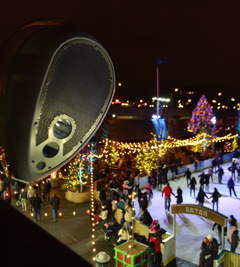
SVC Podcast – Show Notes – Show 139-2:
In this edition of the SVC Podcast, SVC Contributing Editor Bennett Liles continues his discussion with Jeremiah Leiter of Live Sound Company in Williamsport, MD about their installation of a new Deva system from PowerSoft for the RiverRink at Penn’s Landing, an Olympic sized skating rink in the Philadelphia area. Jeremiah gets into the system specs and outlines the installation process of the solar panels which power the Deva at RiverRink.
Links of interest:
- Luca Giorgi from PowerSoft introduces the Deva system and explains its capabilities
- The Deva video from PowerSoft on YouTube
- An installation of the Deva system at the first Diffrazioni Multimedia Festival in Italy
Download Podcast Here:
https://s3.amazonaws.com/nb-svc/public/public/139-2_Powersoft_Deva_Live_…
From Sound & Video Contractor Magazine, this is the SVC Podcast with Jeremiah Leiter. Show notes for the podcast are available on the web site of Sound & Video Contractor Magazine at svconline.com.
The new Deva system from PowerSoft is so versatile it got a great installation for the RiverRink at Penn’s Landing, an Olympic-sized skating rink in the Philadelphia area. Live Sound Company did the job and Jeremiah Leiter is going to give us the specs and tell us how the system works. That’s coming up next on the SVC Podcast.
Jeremiah, thanks for getting back with us for Part 2 on the SVC Podcast from Live Sound Company. We were talking about the PowerSoft Deva installation you did for the RiverRink at Penn’s Landing, a very popular winter gathering place in Philadelphia. This system plays multiple roles. What is inside each one of these Deva units?
The unit is truly a multimedia unit. So you have a speaker inside of it that can reproduce audio. You have a light – an LED light can create a lighting source. It has an infrared camera inside of it. It has a motion detector, amplifier built into it, a Wi-Fi receiver, a SIM card receiver, a battery for internal power that can be charged up either via solar panel or over a standard DC power supply. [Timestamp: 1:37]
Sounds like a lot of stuff really crammed into a small package. How big are these things?
They’re about 12 inches in length, 12 inches in width, and 17 inches in height. And that whole package is actually – comes in at about 22 pounds, so it’s relatively a very small, confined package for everything that it can do. [Timestamp 1:56]
That must have been a real challenge for PowerSoft to come up with that many things tucked into such a small space and to have it work consistently and do all of that outdoors in a sometimes harsh environment.
Absolutely, because they are built to withstand the elements and be outdoors full time, whether that would be an amusement park or a football stadium. They’re weather resistant and I believe that they claim it’s anywhere between -20 to +70 Celsius. So it’s a huge range that these things are set up to take. [Timestamp: 2:29]
Yeah, I guess in the Philadelphia area when people are out there at the rink the colder end of the temperature spec would come into play because that area it can get pretty frigid.
Absolutely. You know it is on the east coast in the mid-Atlantic region, so we see temperatures down into freezing with snow throughout the winter season.
And we were talking in Part 1 about one of the more unique aspects of this, the solar battery that can run it. What’s the capacity of that solar power feature and what happens if you don’t have a sunny day in a while? Does that really cut down on how long it can go?
What the ratings are on this – now again it can change depending on what’s being demanded from the unit. So if the unit’s just doing music playback versus needing to record in HD video, the basic standards that come with this is a stand-by for more than 14 days or approximately 50 hours without being recharged. That’s on an internal battery charge, so the solar panel, it can kind of trickle charge on and off as the light is available to the unit. [Timestamp: 3:32]
Okay. Well, I guess they would have to have some sunny days within that sort of time period.
You know, that is one way that the system works. If it’s in a low-light situation, for example we are looking at putting some of these underneath the I-95 corridor in Philadelphia where it can be more of a low-light situation, you can actually run power over Ethernet and wire them up that way to get DC voltage to them. So there’s many options for many applications. [Timestamp: 3:58]
You can make this thing work just about anywhere without too much wiring or tech stuff going on.
Absolutely.
So you’re putting this thing in and I haven’t talked to a lot of people who have installed wireless solar-powered gear so how critical is the alignment of the solar panels? What do you have to do to set those up? Does that have a substantial effect on the life of the battery? How critical is that?
It is pretty critical. If I can recall accurately from our training from the fine people at PowerSoft, we just had to make sure we had a view of the southern sky so it can get east and west as the sun travels across the sky. We would have to follow-up with PowerSoft to explain why we didn’t face it north, because you figure either north or south would get the sun moving east to west. But I know for this application we just basically needed a view of the southern sky. [Timestamp: 4:45]
Yeah, the more north you get up into that area the more southerly the sun angle is going to be especially during the winter.
Absolutely. That makes sense now that you bring up that point. So yeah, that’s why we’re facing the southern sky.
These things are a video system and a sound system so how much audio power can each of the Deva units handle?
Each of them have an amplifier inside of them that’s a PowerSoft Class D circuitry, which is highly efficient. They’re actually rated at 155 dB at 1 meter, so these little units actually get quite loud. We were really, really surprised. The frequency response that they’re rated at is 100 Hz to 16 K, plus or minus 3 dB so they’re not really something that’s going to be reproducing music with a lot of low-end sub-bass, but any of your general music playback, announcements, it’s a full frequency reproduction. [Timestamp: 5:39]
Yeah, when you’re out there skating around and having a good time you’re probably not going to be a super audiophile, but this will let them hear everything that you’re putting out there.
It’s got an eight-inch loudspeaker built into it, and frankly we were really surprised. We started with two units on each side of the rink. The rink is a standard-sized ice skating rink. And we were really surprised how well they covered the rink for as little or as few units as we were actually deploying in this installation. So we were very, very pleasantly surprised. [Timestamp: 6:11]
You probably do a lot of this and this it’s a fairly unique system. I’m sure there may be others trying to copycat this thing already. What was the biggest challenge for installing this type of paging and camera system in this sort of venue?
The biggest challenge for us, I guess, was the integration with the Wi-Fi system; just making sure that there were no other RF frequencies in the area that were going to interfere. It’s a standard 802.11a/b/g/n/ Wi-Fi system with either a 2.4 or 5 GHz range, which as you know, there’s a lot of devices out there currently. So that was the biggest hurdle we had was just getting that coordination done and then we had somebody from PowerSoft help us through that. As far as actually getting the units mounts and up and turned on and configured with the GUI interface, loading the music, all that was pretty straightforward and pretty painless. [Timestamp: 7:08]
Well that’s good news, especially for PowerSoft when they’re trying to break this product in and get everybody’s attention with it.
I think they really took a lot of time getting all of the components within this unit to talk to each other when they were designing the software interface. They did a really good job at that, because that was my biggest concern is what if one part goes down or there needs to be a firmware update on something else? We didn’t notice any issues when it came to that kind of stuff. It was very plug-and-play. [Timestamp: 7:39]
It sounds like your guys had no problem with this one and this winter the crowd at RiverRink will be having a good time with it I’m sure. So now that you’ve got this one done what’s coming up next for Live Sound Company? Have you got some other projects coming along?
You know, speaking of specifically this product, the Deva product, we’ve been working with a handful of municipalities – talking to them – whether it’s downtown Main Street, any given city. So for Christmastime they can have announcements or music and also some surveillance for any issues that may arise. So there’s a handful of cities along the east coast that we’ve been speaking with. We’ve also talked to some theme parks about integrating this system as well as a few football stadiums and baseball stadiums. So we’re really excited about the potential in the future for this product and really getting it out there and showing the world what it can do. We’re really, really excited about it. [Timestamp: 8:32]
Well since you have the experience now, and this being a brand new system, you guys may just be the ultimate gurus on it right now.
We hope so, but as you know there’s always more to learn. The PowerSoft guys are always developing new things. And that’s one thing we really like about PowerSoft is they really took away from this experience what maybe some other functionality or needs from our client may be. We got some really good feedback from the city saying this is great, but what if it could do this or what if it could do that? And actually taking that back to the drawing board and trying to integrate it into future products, which I think is absolutely awesome. [Timestamp: 09:10]
It has a lot of potential and you’ve gotten in on the ground floor with this product, so I’m sure there will be more to come. It’s Jeremiah Leiter with Live Sound Company and the PowerSoft Deva system at Philadelphia’s RiverRink. Thanks for letting us know about this one.
Awesome. Thank you very much for your time. We appreciate it.
Thank you for being here with us for the SVC Podcast with Jeremiah Leiter. Show notes are available on the website of Sound & Video Contractor Magazine at svconline.com. Join us again for the next SVC Podcast.










